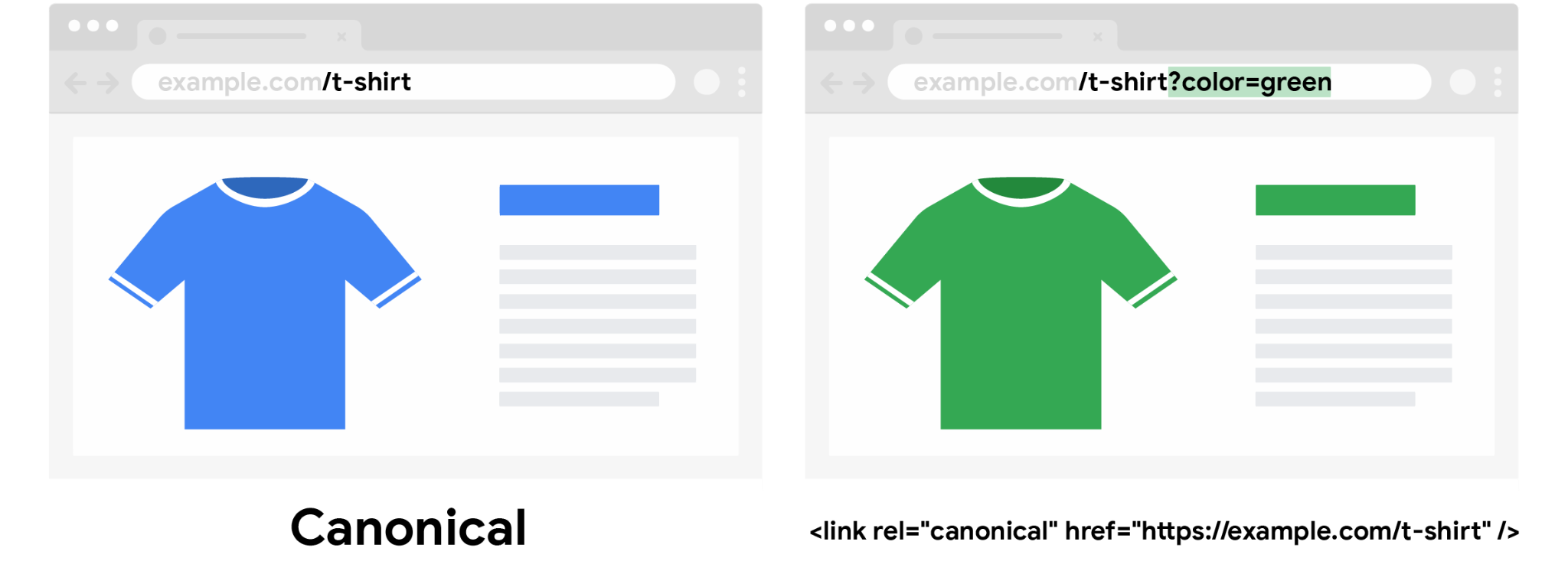전자상거래 웹사이트를 위한 URL 구조 설계하기
잘 설계된 URL을 사용하면 Google이 전자상거래 사이트에서 웹페이지를 더 효율적으로 찾아서 가져올 수 있습니다. URL의 구조를 직접 관리하는 경우(예: 사이트를 처음부터 빌드하는 경우), 이 가이드를 활용하여 Google에서 전자상거래 사이트의 색인 생성 문제가 발생하지 않도록 URL 구조를 결정하세요.
URL 구조가 중요한 이유
URL 구조를 효과적으로 설계하면 Google이 사이트를 크롤링하고 색인을 생성하는 데 도움이 되는 반면, URL 구조가 좋지 않으면 다음과 같은 문제가 발생할 수 있습니다.
-
콘텐츠가 누락될 수 있습니다. 크롤러는 URL 하나만 검색할 수 있으므로(다른 하나는 중복이므로 삭제) Googlebot이 URL 2개가 동일한 콘텐츠를 반환한다고 잘못 판단하는 경우입니다.
#fragment와 같은 프래그먼트 식별자를 사용하여 다른 콘텐츠를 표시하는 경우에 이렇게 될 수 있습니다. Google은 색인 생성에 프래그먼트 식별자를 사용하지 않습니다.예: Google은
/product/t-shirt#black및/product/t-shirt#white를 동일한 페이지로 간주합니다. -
크롤러가 동일한 콘텐츠를 여러 번 검색할 수 있습니다. URL 2개가 서로 다르지만 반환되는 페이지는 동일하다고 Google이 잘못 판단하는 경우입니다. 이로 인해 사이트 크롤링 속도가 느려지고 웹 서버에 불필요한 추가 부하가 발생할 수 있습니다.
예:
/product/black-t-shirt와/product?sku=1234가 동일한 제품 페이지를 반환할 수 있지만, Google은 URL만 보아서는 이를 확인할 수 없습니다. -
크롤러가 사이트에 포함된 페이지 수가 무한하다고 판단할 수 있습니다. URL에 계속 변경되는 값(예: 타임스탬프)이 포함된 경우입니다. 그 결과 Google이 사이트에서 유용한 콘텐츠를 모두 찾는 데 시간이 더 걸릴 수 있습니다.
예:
/about?now=12:34am과/about?now=12:35am모두 동일한 페이지를 표시하지만 Google은 다른 URL로 취급할 수 있습니다.
Google이 사이트를 크롤링하고 사이트의 색인을 생성하는 방법에 관한 자세한 내용은 Google 검색 작동 방식 및 Google 사이트 크롤러의 사이트 색인 생성 방법을 참고하세요.
효과적인 URL 구조 설계 권장사항
Google에서 웹사이트를 크롤링하고 색인을 생성하는 방법을 최적화하려면 URL 구조 설계 방법에 관한 다음 권장사항을 따르세요.
일반적인 URL 권장사항
- 동일한 콘텐츠를 반환하는 대체 URL 수를 최소화하여 Google이 사이트에 필요 이상으로 많은 요청을 보내지 않도록 하세요. Google은 두 URL이 모두 검색될 때까지 동일한 페이지가 반환된다는 사실을 인식하지 못할 수 있습니다.
- URL의 대소문자 텍스트가 웹 서버에서 동일하게 처리되는 경우 모든 텍스트의 대소문자를 동일하게 변환하세요. 그러면 Google에서 URL이 동일한 페이지를 참조한다고 더 쉽게 판단할 수 있습니다.
- 페이지로 나눈 각 검색결과 페이지에 고유한 URL을 사용하세요. 페이지로 나누기 URL 구조에서 URL 오류가 가장 많이 발생합니다.
-
URL 경로에 설명하는 단어를 추가하세요. URL의 단어는 Google이 페이지를 더 잘 이해하는 데 도움이 될 수 있습니다.
권장:
/product/black-t-shirt-with-a-white-collar권장하지 않음:
/product/3243
URL 쿼리 매개변수 권장사항
Google이 사이트를 정상적으로 크롤링하고 색인을 생성할 수 있도록 쿼리 매개변수를 사용할 때 다음 권장사항을 따르세요.
-
가능하면 URL 매개변수로
?value대신?key=value를 사용하세요. URL 매개변수를 사용하면 Google 검색에서 사이트의 구조를 파악하여 더 효율적으로 크롤링하고 색인을 생성할 수 있습니다.권장:
/photo-frames?page=2,/t-shirt?color=green권장하지 않음:
/photo-frames?2,/t-shirt?green -
같은 매개변수를 두 번 사용하지 않도록 하세요. Googlebot이 매개변수 값 중 하나를 무시할 수도 있습니다.
권장:
?type=candy,sweet권장하지 않음:
?type=candy&type=sweet -
세션 ID, 추적 코드, 사용자 관련 값(
location=nearby,time=last-week), 현재 시간 같은 임시 매개변수를 내부 링크로 연결하지 마세요. 그러면 수명이 짧은 URL이나 동일한 페이지의 중복 URL이 생성될 수 있습니다. Google 검색에서 최상의 결과를 얻으려면 장기적으로 사용할 수 있는 영구 URL을 사용하세요.권장:
/t-shirt?location=UK권장하지 않음:
/t-shirt?location=nearby,/t-shirt?current-time=12:02,/t-shirt?session=123123123
Google이 제품 옵션의 URL을 이해하는 방법
일반적으로 전자상거래 사이트에서는 제품을 여러 크기 또는 색상으로 제공할 때 URL을 구조화하는 방법을 고려해야 합니다. 각 제품 속성의 조합을 제품 옵션이라고 합니다. Google에서 제품 옵션을 이해할 수 있도록 각 옵션을 별도의 URL로 식별할 수 있는지 확인하세요. 옵션 URL에는 다음 URL 구조를 사용하는 것이 좋습니다.
-
경로 세그먼트(예:
/t-shirt/green) -
쿼리 매개변수(예:
/t-shirt?color=green)
자세한 내용은 구조화된 제품 옵션 데이터 문서를 참고하세요.
선택적 쿼리 매개변수를 사용하여 옵션을 식별하는 경우 쿼리 매개변수가 생략된 URL을 표준 URL로 사용합니다. 이렇게 하면 Google이 제품 옵션 간의 관계를 이해하는 데 도움이 됩니다.

콘텐츠에 URL 사용하기
Google 검색 및 Google 쇼핑에서 제품 및 제품 옵션 간의 관계를 제대로 식별하도록 하려면 콘텐츠에 URL을 사용할 때 다음 권장사항을 따르세요.
-
내부 링크, 사이트맵 파일 및
<link rel="canonical">태그에서 동일한 URL을 사용합니다. 예를 들어 1페이지가 기본 페이지일 때 쿼리 매개변수를 사용하여 페이지로 나뉜 시퀀스의 첫 번째 페이지에 링크로 연결하는 경우, 사이트 전체의 URL에 일관성 있게?page=1을 포함하거나 제외합니다. -
색인을 생성할 수 있는 모든 페이지에 자체 참조
<link rel="canonical">태그(태그의 URL이 현재 페이지를 가리킴)를 사용하고 이러한 URL을 sitemap 파일에 포함합니다. -
옵션마다 고유한 URL이 있는 제품의 경우
<link rel="canonical">태그를 사용하여 모든 옵션 페이지에 표준 제품 URL을 포함합니다. 자세한 내용은 Google 판매자 센터의canonical_link속성을 참고하세요. -
<a href>태그를 사용하여 페이지에 직접 링크를 포함합니다. 자바스크립트를 사용하여 페이지 간에 이동하지 마세요. Googlebot은 자바스크립트 코드에서 이동을 감지하지 못할 수 있습니다. Google에서 자바스크립트를 처리하는 방법을 자세히 알아보려면 자바스크립트 검색엔진 최적화의 기본사항 이해하기를 참고하세요. -
가능하면
<a href>와</a>태그 사이에 의미 있는 텍스트(예: 링크로 연결된 제품의 제목)를 포함합니다. '여기를 클릭하세요'와 같은 일반적인 문구를 사용하지 마세요. -
유용한 콘텐츠가 없는 페이지에 링크로 연결하지 말고, 최소한 색인은 생성하지 않도록 합니다. 카테고리에 항목이 없으면
noindexrobotsmeta태그를 사용합니다. 사이트에서 비어 있는 카테고리를 감지하고 사이트 내 검색 및 탐색에서 자동으로 해당 카테고리를 삭제하는 경우 페이지의404 (not found)HTTP 상태 코드를 반환하는 것이 좋습니다.
추가 리소스
자세한 내용이 궁금하신가요? 다음 리소스를 확인하세요.
